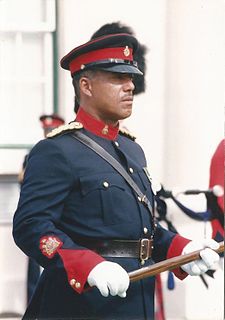Warrant officer is an officer in a military organization who is designated by a warrant, as distinguished from a commissioned officer.

A warrant officer (WO) is an officer in a military organisation who is designated an officer by a warrant, as distinguished from a commissioned officer who is designated an officer by a commission, and a non-commissioned officer who is designated an officer, often by virtue of seniority.
Warrant officer or Warrant Officer may also refer to:
- Warrant officer (United Kingdom), the highest non-commissioned rank in the British Armed Forces
- Warrant officer (United States), an officer above the senior-most enlisted ranks, as well as officer cadets and candidates, but below the officer grade
- Assistant warrant officer, a rank in Pakistan Air Force above Senior Technician and below Warrant Officer
- Canadian Forces Chief Warrant Officer, the senior non-commissioned member appointment in the Canadian Forces
- Chief of the Air Staff's Warrant Officer, the senior warrant officer of the Royal Air Force
- Chief warrant officer, the most senior Army and Air Force non-commissioned member (NCM) rank of the Canadian Forces
- First warrant officer, a Warrant Officer rank in the Singapore Armed Forces
- Master warrant officer, a military rank in the Canadian Forces and the Singapore Armed Forces
- SAF Warrant Officer School, a Singapore Armed Forces training school within the Pasir Laba Camp complex for Master Sergeants
- Second warrant officer, a Warrant Officer rank in the Singapore Armed Forces
- Senior warrant officer, a Warrant Officer rank in the Singapore Armed Forces
- Station Warrant Officer, the senior Warrant Officer on a British Royal Air Force station (base)
- Third warrant officer, a Warrant Officer rank in the Singapore Armed Forces
- Warrant Officer Basic Course, technical training a new US Army Warrant Officer receives after warrant officer candidate school
- Warrant Officer Candidate School (United States Army), the entry-level training for Warrant Officer Candidates in the United States Army
- Warrant Officer of the Navy, the most senior non commissioned officer rank in the Royal Australian Navy (RAN)

A warrant officer (WO) in the British Armed Forces is a member of the highest group of non-commissioned ranks, holding the Queen's warrant, which is signed by the Secretary of State for Defence. Warrant officers are not saluted as they do not hold the Queen's Commission, however they are to be addressed as 'Sir/Ma'am' by subordinates. Commissioned officers may address warrant officers either by their appointment or as "Mister", "Mrs", or "Ms" and then their last name, e.g. "Mr Smith". Although often referred to along with non-commissioned officers (NCOs), they are not NCOs, but members of a separate group, although all have been promoted from NCO rank.

In the United States Armed Forces, the ranks of warrant officer are rated as officers above senior non-commissioned officers, candidates, cadets, and midshipmen but subordinate to the officer grade of O‑1. This application differs from the Commonwealth of Nations and other militaries, where warrant officers are the most senior of the other ranks, equivalent to the US Armed Forces grades of E‑8 and E‑9.
Assistant warrant officer is a rank in the Pakistan Air Force above chief technician and below warrant officer. It is equivalent to the Pakistan Army's naib subedar and the Pakistan Navy's chief petty officer.


